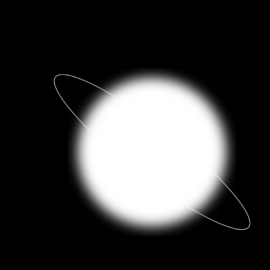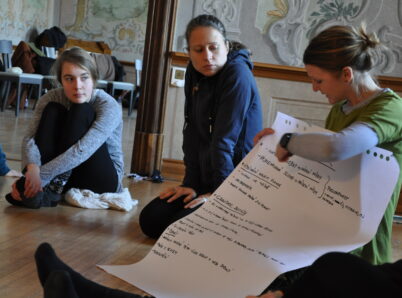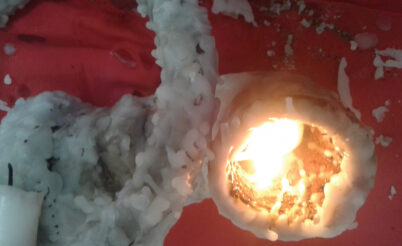
Eva Urbanová: Hungry Hearts
I’ve talked with Eva Urbanová – dancer, choreographer, dance maker – who was one of the residents taking part in this year’s Coaching Residencies, about her work on the piece she recently presented as her final work at HAMU (Academy of Performing Arts – Music and Dance Department). We’ve dwelled into the process of her work and the topics she was addressing together with eight performers coming from different backgrounds. We talked about the numb, hectic skin avoiding encounter and the vulnerability of becoming intimate with the other in her choreographic process.
Zuzana: So dear, welcome to this amazing interview.
Eva: I’m so excited.
Zuzana: ? But maybe firstly, just describe to me what actually happened during your performance?
You were just telling me that you had presented your master piece on Thursday a week ago, and I know you were working on its final part during the Residency with Coaching. So let’s start with this – what was it, and how was it for you?
Eva: This piece is called Hungry Hearts and it was my final choreographic project of my MA studies at the Academy of Performing Arts in Prague, which is a two-year-long study program.
I started to work on these ideas two years ago. The main theme of the piece back then was vulnerability. Two years ago, it was called The Power of Vulnerability and during that time I was working with another performer, Agáta Jarošová, who had also worked with SE.S.TA before and did the Coaching Residency two years ago. The thing is, I was not really satisfied with how the piece evolved, how I created it, and I felt there was much more to explore. I decided to continue working on this topic and develop it for my master thesis.
Within the piece I was connecting several concepts – like millennials, busy and fast lifestyles in cities, consumer society, and capitalism. I was thinking about how we are disconnected from ourselves as people, and about this hunger for life that we have inside us, and that there is something that needs to be fulfilled. I was questioning how we get our hearts fulfilled.
And it’s not only vulnerability, but also playfulness and intimacy which go along with it. Our generation – if I can call us millennials – we are more connected to technology than to the people around us. And this time I was working with eight performers. There were two dancers who formed the main duo. They were more experienced with contemporary dance than the rest of the group, which I call the ensemble – girls who were a little younger. From the beginning I knew I would have two main performers who would hold the whole piece, and the rest would amplify the situation with their intentions, their presence, and energies.
I also wanted to present this piece outside of the theatre space. I wanted to research how the body would be perceived when placed outside of the classical frame of the black box and outside of classical audience expectations. I decided not to use any light design and to stick only with daylight, which made me think of how I could connect the audience and performers.
Zuzana: When you talk about this question of the visitor, or the relation between performer and audience – which also very much resonated during your Coaching Residency… I wanted to ask: why are you going out of the black box and coming into the gallery space? Is this some kind of homogeneous space where you are creating a similar condition for the visitor and performer? What were the strategies, and how were you exploring the relationship with the visitor? What kind of methods did you find throughout the process?
Eva: The place we were working in was the Korzo in the National Gallery in Prague, a space with big windows where people passing outside can observe what is happening inside. And this disposition worked quite well with the idea I had in the beginning. During the work-in-progress presentation, people could move around and change their point of view and angles. I asked them to move and gave them the option to sit, stand, or walk. This was creating a different energetic field in the space. I wanted to explore what it would be like if people moved from one side and the energy wasn’t settled. These experiments during the rehearsal process brought lots of new ideas that I’d like to explore in future pieces.
But actually, for this piece I decided to let people sit on two sides. During the rehearsals in the gallery we worked also with the moving walls on wheels, which are part of the Korzo’s architecture. I felt that I couldn’t risk the safety of the audience, so we decided to place them into two corners (in two groups). These groups could watch each other and also observe what was happening outside. Similarly, people from the outside could observe what was happening inside.
Zuzana: So you were pretty much involved with the work on architecture. Because the gallery space allowed you to work on inside and outside at the same time, entangling the gallery space with the public space. And this was also creating a specific scenography…
Eva: Yes, and at the end of the piece all the dancers went outside and were performing in the public space for the audience who was inside.
Zuzana: Coming back to the choreographic work – material related to your topic: vulnerability, intimacy… Could you develop this a little more? How were you working on the choreographic score? What kind of tools were you using? How were you expressing intimacy? Was intimacy your tool or score or…?
Eva: In this case, I think what was really interesting was creating the material with the two main dancers. They hadn’t met before. They were coming from different backgrounds. It was very organic throughout the process to work on their vulnerability and intimacy between each other. They had to overcome an uncomfortable situation to open up and show who they are.
I chose some improvisational principles and tasks as part of the score for them. We were exploring what is happening before, after, and during a hug – and also the quality of melting. We were observing muscle tension, exploring how the dancer can soften them, how fasciae work. Within the partner work, we explored how we can grow from a hug to lifting. Support was another element that we worked with. These principles we later brought into the group choreography.
Zuzana: So you kind of created a scene of different things, also different dynamics or colours, coming from the idea of hugging, melting, and support – which later created the material for the choreography. Maybe I’d come back here to the question of choreography… As you were mentioning architecture, urban space, accumulation – were you also applying these principles in relation to movement in the space?
Eva: There were two worlds in the piece. One was the world of vulnerability, playfulness, and intimacy – and the other was the world of the city. In the city world we created material based on linear movements of our bodies. Another element in this part was a stylised civil walk.
Zuzana: What is the stylised civil walk?
Eva: I wanted them to hold their torso in the axes. So there is no movement of opening or closing the torso. At the same time, we were keeping “the middle points.” You find the point in front of your heart and on the back of your heart. Then you find a middle point inside your chest, which connects these two points. After that, you find lots of these middle points on your torso in different places.
Zuzana: It’s reminding me of a chakra chain.
Eva: Yes, a similar image. However, it’s a bit robotic. It holds the body in a certain restricted position and creates a cold mood for the performers and the performativity – this sense of coldness that I wanted to bring into the space. It’s not about moving or creating – you’re not opening or closing your body parts. This was one of the main principles we worked with in this scene.
The world of vulnerability evolves into intimacy and playfulness, but the world of the city goes in the opposite direction. Performers are people with senses, but they don’t use their bodies the way they could – they don’t express themselves, and that’s why they can easily go to the other side, which I call the dark side. They have a lot of shaking moments. Each of them has a slightly different story. It’s a constant falling down – they are loosening their muscles, their balance – each of them has different movement qualities. In the world of vulnerability we worked mainly with soft movements, diagonals, and melting muscles.
Zuzana: Speaking about the darker movements – what were the triggers for them?
Eva: We were trying a lot of things. One task was inspired by the morning walk in the metro station, when people are passing around you. Being in a rush and in a crowded place – a lot of times, they bump into your shoulder. Some people say “I’m sorry,” some don’t even have time to say anything, and some people don’t even feel the touch. They are in the box of their mind and their skin has lost sensitivity.
This is what happens after the dancers start walking in the first scene. They start to bump into each other’s shoulders. The more bumps you receive, the more of the dark world appears in your dance. The music is the cue for the dancers. The music gets faster and more layers appear in the score. This creates the atmosphere of a busy city.
Zuzana: If we zoom out and observe the dramaturgy of the piece – how would you describe the curve? What kind of city are we experiencing by watching it?
Eva: I imagine something like a huge city. I lived in London and Tokyo. The materials in the gallery are cold – marble… dancers didn’t like it. If you imagine the centre of NYC or Tokyo, people are surrounded by these cold materials.
Through the dancers’ bodies I wanted to bring the contrast, so I focused on softening the muscles. I was departing from the image of the abandoned city where nature is growing through the buildings. The eight dancers were creating connections through their arms, crawling on the ground. In the city world, they are individuals disconnected from each other. In the vulnerability scenes, we wanted to create connectedness – like plants do through their rooting systems.
Zuzana: And why were you working only with girls?
Eva: It wasn’t that I made a strict decision about it. But somehow, only girls wanted to work with me.
Zuzana: I’m asking whether it was a certain statement. And also, I’m asking because you had to work with eight performers – was it a condition for the master project at school?
Eva: They wanted me to work with a group. Officially you have to work with at least three performers. I wanted to work with ten – and I got eight.
Zuzana: You speak about the millennial generation. But you are also working with teenage girls and “grown-ups” ? … Teenagerhood is also a hectic, dynamic period, and it’s very much about encountering first sexual intimacy. Teenage is a time when you do things for the first time. You also described how the younger dancers were changing the energy in the group or how they influenced the work…
Eva: I didn’t mean young by age, but by performing – like performing contemporary dance… young performers more by experience in the contemporary dance scene. And yes, there was an age difference too.
What was interesting for me was to experience their various backgrounds. It was interesting to observe how people coming from different contexts can work together. I had to step out of my style and go more into conversation with them. It was really crucial for me that they came from different backgrounds, bringing their knowledge to the basket – and this very much worked with the topic of the piece. Even though we are so different, we can still enjoy life together.
Zuzana: Last question – are you going to continue with this? Or do you think you found the final form for the piece?
Eva: It was a very hard process for me. We didn’t have much time. I would have appreciated more time to experiment inside the gallery space. And I also got lost in the idea throughout the time. But let’s see – maybe after the winter and the Corona crisis… I think I want to continue to work on this topic and explore it more in the future, for sure – and also explore dance in the gallery space.
Zuzana: So you feel like going out of the black box?
Eva: Yes.
Zuzana: Maybe it would be nice if you could establish a collaboration with the National Gallery. And I think generally, it would be great also for other artists, performers, choreographers, dancers – if the National Gallery opened its spaces for performing artists and let them rehearse throughout the space.
Eva: Yes! It was a very nice experience. For example, during rehearsal time, people walking by or visitors were reacting to what we were working on in the space.
Zuzana: Good to hear. Thank you, Eva, very much for the interview!
Eva: Thank you!




